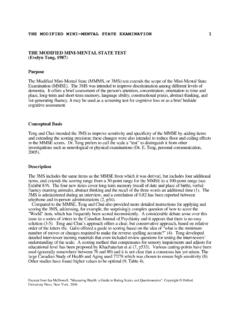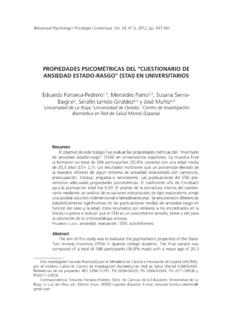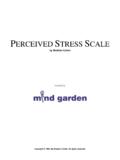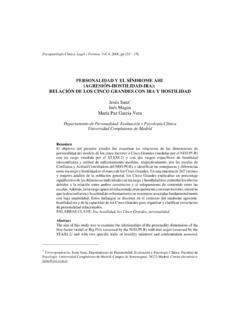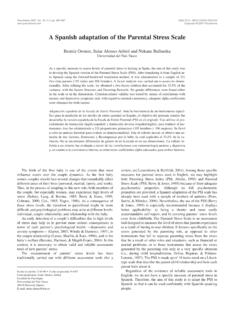Transcription of THE STATE-TRAIT ANXIETY INVENTORY (C.H. Spielberger, …
1 THE STATE-TRAIT ANXIETY INVENTORY1 Excerpt from Ian McDowell, "Measuring Health: a Guide to Rating Scales and Questionnaires". Copyright OxfordUniversity Press, New York, 2006 THE STATE-TRAIT ANXIETY INVENTORY ( spielberger , 1968, 1977)PurposeThis self-report measure indicates the intensity of feelings of ANXIETY ; it distinguishes between stateanxiety (a temporary condition experienced in specific situations) and trait ANXIETY (a general tendencyto perceive situations as threatening). It was originally developed as a research instrument to studyanxiety in normal adult population samples, but it can also be used to screen for ANXIETY disorders andcan be used with patient samples (1), p3).
2 Conceptual BasisSpielberger developed the STAI in the context of his experimental work on the links between anxietyand learning ability, and reflected limitations in existing measures of ANXIETY for use in such research (2). Early measures of ANXIETY such as Taylor s 1953 Manifest ANXIETY Scale (TMAS) characterized anxietyas a trait or personality predisposition to react in a particular way to stressful situations (3). During the1960s, Cattell used multivariate analyses to examine the structure of questionnaire items deemed tomeasure ANXIETY , and empirically distinguished between trait and state components (3), p9). Meanwhile, spielberger reviewed Taylor s scale and concluded that it tapped a broad construct thatshould be differentiated into components such as stress, threat, state and trait ANXIETY (2), p139).
3 Heproposed an instrument with trait and state sub-scales that would represent Cattell s perspective, andthat would also reflect Freud s theory of ANXIETY as a response to danger (3), p10). State ANXIETY refers to transitory unpleasant feelings of apprehension, tension, nervousness or worry,often accompanied by activation of the autonomic nervous system; it reflects how threatening a personperceives his environment to be. spielberger referred to it as a temporal cross-section in theemotional stream-of-life of a person (3), p10). Trait ANXIETY is a personality disposition that describesa person s tendency to perceive situations as threatening, and hence to experience state ANXIETY instressful situations (4).
4 Trait ANXIETY is not observed directly, but is expressed as state ANXIETY whenstress is experienced (5), p204). spielberger drew an analogy with energy: trait ANXIETY would beequivalent to potential energy, and state to kinetic energy (1), p3). As emotions play a crucial role indetermining how patients react to a diagnosis and ANXIETY is central in this process, spielberger arguedthat it is important to assess ANXIETY in routine clinical of the STAI began in the early 1960s with research on high school and college students. Items for the scale were drawn from the TMAS and from Cattell s scale, and further items were writtenas the development progressed (1), p19; (6).
5 The initial intent was to select items that could be usedboth for state and trait ANXIETY , but using a different time reference ( , feelings now, versus feelings ingeneral). This proved infeasible, however, as some of the most suitable items for each scale could notbe phrased to fit the other: I feel upset was a good state item, but did not fit on the trait scale (1), p9;(3), p11). For the original version (Form X), spielberger selected 20 items for each scale, of which 5 Excerpt from Ian McDowell, "Measuring Health: a Guide to Rating Scales and Questionnaires". Copyright OxfordUniversity Press, New York, 2006 Include Exhibit about is below were common to both.
6 The trait scale was largely based on the TMAS, while state ANXIETY items werechosen as being sensitive to stressful situations (6). Copies of the Form X version are included in the1970 manual (1), pp20-21), while the newer Form Y is included in the 1983 manual (7), pp36ff). During the late 1970s, Form X was revised to discriminate more clearly between ANXIETY anddepression and to improve psychometric properties, including the factor structure. Twelve of theoriginal 40 items were replaced, including items that did not work well with less educated respondentsand others that appeared to measure depression (7-10). This led to Form Y which, with recent minormodifications, remains in current use.
7 However, Form X continued to be used in published studies wellinto the 1990s, and as much of the validity and reliability evidence for the STAI was derived from theForm X version, the following review combines information from both versions. Items 1 - 20 measure situational or state ANXIETY (STAI-S), and items 21 - 40 measure underlying ortrait ANXIETY (STAI-T). Both scales were intended to form unidimensional measures. For the stateitems, respondents are asked to indicate How you feel right now, that is, at this moment. Responsesindicate intensity of feeling on a 1 to 4 scale, from not at all through somewhat , moderately so to very much so.
8 For the trait items the question concerns how you generally feel and the responsescale indicates frequency: almost never , sometimes , often and almost always. After reversingscores for positively-worded items, total scores for state and trait are calculated, ranging from 20 - 80. Copyright prevents reproduction of the full scale here, but sample items are shown in Exhibit andthe content of the items is summarized in various publications ( , references (11); (12), Table 1; (13),Table 1). Copies of the STAI are available through the Mind Garden company( ). Exhibit Examples of items from the STATE-TRAIT ANXIETY InventoryThe S- ANXIETY scale consists of twenty statements that evaluate how respondents feel right now, at thismoment 1 = NOT AT ALL 2 = SOMEWHAT 3 = MODERATELY SO 4 = VERY MUCH SOA.
9 I feel at ease .. 1 2 3 4 B. I feel upset .. 1 2 3 4 The T- ANXIETY scale consists of twenty statements that evaluate how respondents feel generally 1 = ALMOST NEVER 2 = SOMETIMES 3 = OFTEN 4 = ALMOST ALWAYS A. I am a steady person .. 1 2 3 4 B. I lack self-confidence .. 1 2 3 4 THE STATE-TRAIT ANXIETY INVENTORY3 Excerpt from Ian McDowell, "Measuring Health: a Guide to Rating Scales and Questionnaires". Copyright OxfordUniversity Press, New York, 2006 Reproduced with permission of Mind Garden Inc, 1690 Woodside Rd # 202, Redwood City, CA94061 (650) 261-3500 ReliabilityNumerous studies have reported alpha internal consistency, which is consistently high.
10 Selected resultsare shown in Table Table Internal Consistency Coefficients (alpha or K-R20) for the STAI, Versions X and YStudy sample State scaleTrait scaleReferenceStudents (Form X) - - (4), p332)Students (Form Y) - - (7), Table 1)Undergraduate male (1), Table 3)Undergraduate female (1), Table 3)Adult psychiatric (14), p378)General (15), p283)Working adults (Form Y) (7), Table 1)Anxious older (16), Table 2)Students: low stress (17), Table 3)Students: high stress (17), Table 3)Students (2 samples); low ; ; (6), p533)Pain patients; different ethnic - - (18), Table 3)Parents of young (19), Table 1)Surgical patients, cancer patients &medical (20), Table 4) Internal consistency tends to be higher under conditions of stress, although this is not completelyconsistent.
